My camera is currently on vacation somewhere else, and I will post pictures once I get it back.
They just re-entered hibernation as of July 1st.
You can put them into hibernation whenever? It doesn't matter the timing of the year?

My camera is currently on vacation somewhere else, and I will post pictures once I get it back.
They just re-entered hibernation as of July 1st.
You can put them into hibernation whenever? It doesn't matter the timing of the year?
update this!! i jsut got a camp nova colony and i can't wait for mine to grow as big as yours!
Owner of MichiganAnts, a YouTube Channel dedicated to all my Michigan colonies found and raise in my backyard
https://www.youtube.com/MichiganAnts
https://twitter.com/MichiganAnts
https://www.facebook.com/MichiganAnts/
Keeper of:
Camponotus Pennsylvanicus
Camponotus Noveboracensis
Tetramorium
They actually just came out of hibernation yesterday.
"Always do right. This will gratify some people, and astound the rest." -- Samuel Clemens
wow, and here i am trying to hibernate mine. i just got a camp. nova and she has ~16 workers and ~100 eggs, so i should be catching up to you in a year or 2 lol
Owner of MichiganAnts, a YouTube Channel dedicated to all my Michigan colonies found and raise in my backyard
https://www.youtube.com/MichiganAnts
https://twitter.com/MichiganAnts
https://www.facebook.com/MichiganAnts/
Keeper of:
Camponotus Pennsylvanicus
Camponotus Noveboracensis
Tetramorium
What criteria do you use when deciding to put colonies in hibernation, Crystal? Just when they seem ready, and ignore the time of the year?
What criteria do you use when deciding to put colonies in hibernation, Crystal? Just when they seem ready, and ignore the time of the year?
When the colony is ready. They can be tricked when it comes to hibernation time (ex. 3-4 months vs 6months), but they generally exactly how long 'summer' is supposed to be.
When the colony goes dormant and gasters are distended I know that they are ready for hibernation.
"Always do right. This will gratify some people, and astound the rest." -- Samuel Clemens
Does this species not hibernate in the winter?
My Current Colonies:
Does this species not hibernate in the winter?
All species in my location hibernate. I just happen to have most on reverse hibernation. You can tweak their 'summer' by altering how long you leave them in hibernation.
These went into hibernation in July, and came out in October, that is 4 months. My local winter is about 7 months.
"Always do right. This will gratify some people, and astound the rest." -- Samuel Clemens
Does this species not hibernate in the winter?
All species in my location hibernate. I just happen to have most on reverse hibernation. You can tweak their 'summer' by altering how long you leave them in hibernation.
These went into hibernation in July, and came out in October, that is 4 months. My local winter is about 7 months.
I really like doing this too, esp. since winter in the Great White North is so long. Always nice to have at least one colony going at all times ![]()
Can't wait to see how big this colony gets this Season ![]()
Here are some pictures for the record. Lost half a dozen workers in hibernation, probably some of the older ones. Queen is alert and the overwintered larvae look healthy.
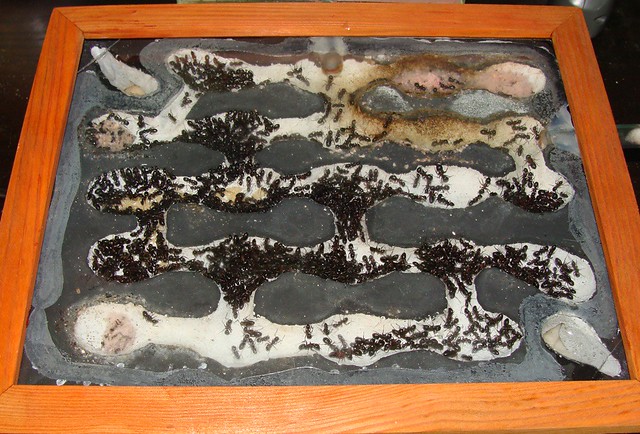
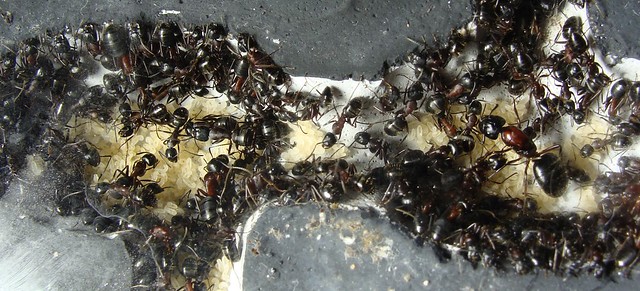
Edited by Crystals, December 28 2017 - 9:19 AM.
"Always do right. This will gratify some people, and astound the rest." -- Samuel Clemens
what is with the pink stuff?
what is with the pink stuff?
It is cotton that was from a test tube with hummingbird nectar. They carried it in during hibernation. They have already packed it into the foraging area for me to clean up.
"Always do right. This will gratify some people, and astound the rest." -- Samuel Clemens
What do you feed these girls??
What do you feed these girls??
Mostly mealworms and crickets. They occasionally get fruit flies and various other insects that I found outside in summer and just froze.
I occasionally offer table scraps, they are very partial to greasy cooked chicken and fish.
I always have hummingbird nectar available and when they first come out of hibernation they hit it very hard. They have probably drank over 5 tablespoons of nectar since waking up. I have watched gasters swell up noticeably and the overwintered larvae plump up, but I still can't figure out where they are putting it all.
"Always do right. This will gratify some people, and astound the rest." -- Samuel Clemens
My Camponotus floridanus have access to hummingbird nectar and syrup at all times, and I will get them superworms. They never eat the superworms, and I never see their gasters full.
My Camponotus floridanus have access to hummingbird nectar and syrup at all times, and I will get them superworms. They never eat the superworms, and I never see their gasters full.
Species found where snow falls for half of the year, and species found in much warmer locations can behave differently.
I suggest starting a new thread/journal for your colony and we can go over suggestions and other things.
The list of Preferred Foods may give you some ideas in the mean time - http://www.formicult...d-by-species/ Ants like variety, just like we do.
"Always do right. This will gratify some people, and astound the rest." -- Samuel Clemens
Crystals, its great to see how excited you are for this colony! I would love to see this colony with alates!
Current Colonies;
Acromyrmex Versicolor
Dorymyrmex Bicolor
Pogonomyrmex Californicus
Pogonomyrmex Rugosus
Pogonomyrmex Tenuispinus
Novomessor Cockerelli
Myrmecocystus Mexicanus
Last Update: 08 Jul 2016
The colony is doing very well despite some light neglect on my part. They are chowing down 4-6 large meal worms every two days and are devouring hummingbird nectar like candy.
Lots of the larvae have started to pupae, some are still growing. None are large enough for alates (for which I am grateful), but it looks like I might be getting more majors.
The egg pile is too large to even estimate a count. I have a rough estimate of 600-800 workers and probably half that amount in brood. I have at least 70 in the foraging area hanging out at all times.
I am encountering a difficulty though, the workers have not forgotten their trick from last year when they discovered how to chew the edge of the vinyl tubing. They always chew the bottom section, where I am least likely to notice it. And within two months managed to chew a 1.5cm long section and I had a small jail break on my hands. About 50 workers took cover under the nest and I ended up dropping them all back in the nest.
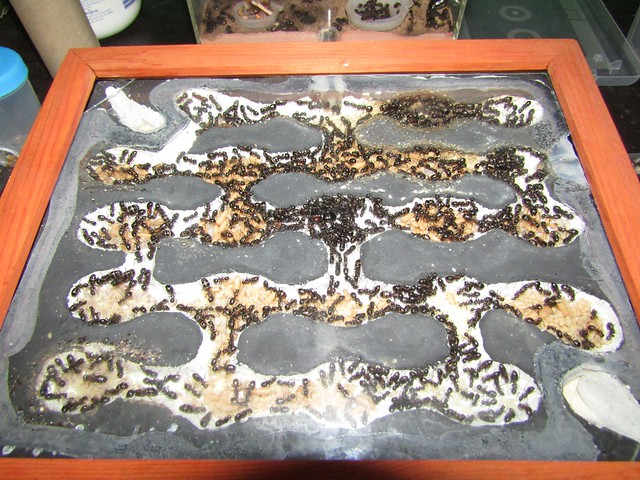
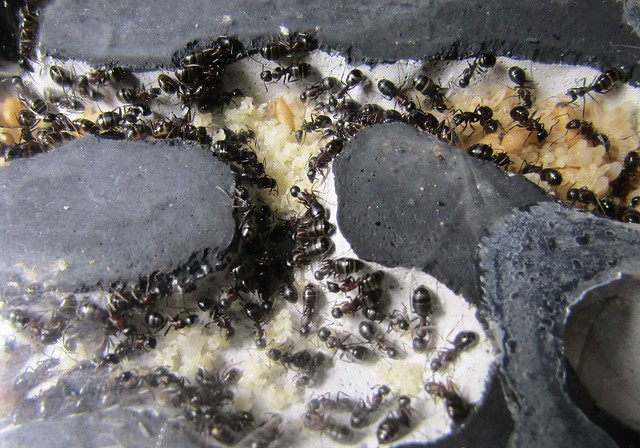
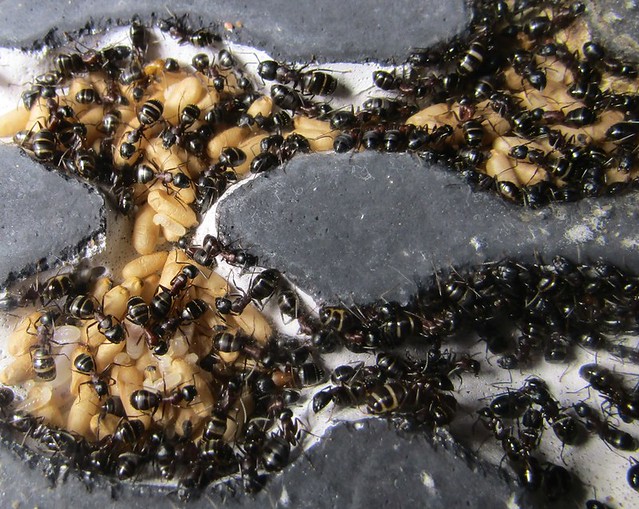
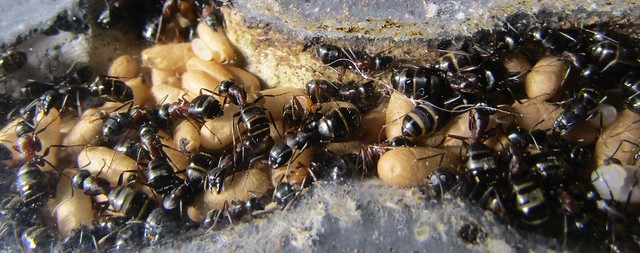
Edited by Crystals, December 28 2017 - 9:22 AM.
"Always do right. This will gratify some people, and astound the rest." -- Samuel Clemens
i have a Camponotus nicobarensis but all the formicariums i buy always seem to mould
i have a Camponotus nicobarensis but all the formicariums i buy always seem to mould
Depends on the type of material it is made out of. Plaster of paris is famous for mold. I use grout, and it doesn't mold. See the Handy Links list in my signature, there is a link in there on the pros and cons of various nest building mediums.
"Always do right. This will gratify some people, and astound the rest." -- Samuel Clemens
0 members, 1 guests, 0 anonymous users